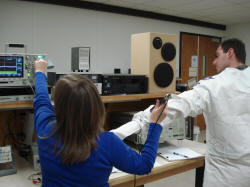Coordinated Tasks
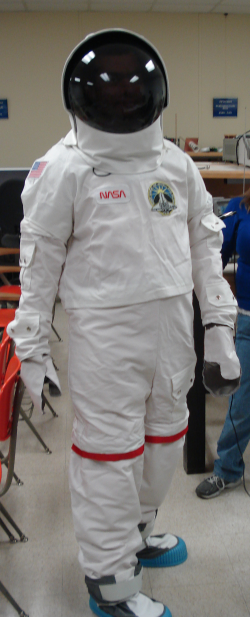
MOTIVATION
This work is part of a NASA EPSCoR project at Kansas State University titled “Biosensor Networks and Telecommunication Subsystems for Long Duration Missions, EVA Suits, and Robotic Precursor Scout Missions.” Current space suits primarily monitor ECG signals. Synergistically, we have seen many wireless biosensors appearing in the commercial market. This study looks at applying similar technology in future suits. These sensors will provide more biomedical data and be easier to adapt as well as less expensive than their wired counterparts.
UNDERSTANDING SPACE SUIT ENVIRONMENT
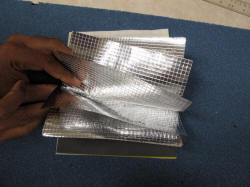
Before adding any elements to the space suit, we needed to understand its radio properties. In an effort to learn more about the layers of the suit, the team visited the Kansas Cosmosphere and Space Center in Hutchinson, KS. During the visit, they saw archived Apollo-era suits and did initial testing on the suits’ radio characteristics (see below). The Thermal Micrometeoroid Garment (TMG) is designed to protect astronauts from micrometeoroids and space debris and to maintain a safe in-suit temperature. The aluminized-mylar layers used should also keep any radio signals inside the suit. To verify this, we contacted ILC Dover and received a sample of current-generation suit material. Using a car key-fob radio transmitter, we tested the sample and found the signal to indeed be blocked by the suit materials. In addition to the TMG, the Liquid Cooling and Ventilation Garment (LCVG) is of interest for potential energy harvesting applications. The LCVG wicks away perspiration and removes excess heat generated by the astronaut. The temperature difference between the LCVG and the astronaut's skin could be converted from heat to electrical power to avoid concerns about the use of battery power within the oxygen-rich suit environment.
BUILDING A SPACE SUIT
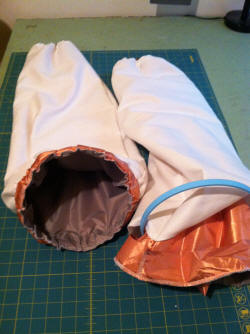 .
.
As part of an effort to understand the propagation of waves in the space suit, we built a full-scale model. We purchased two different metallic fabrics and metallic Velcro. A pattern was developed based on a picture of the EMU Suit. To help fill out the suit, we used sewing hoops. The knee joints also utilized hoops to create an interlocking joint. All other joints are attached using Velcro. The model suit was then used to measure in-suit propagation.
MODEL SUIT TESTING
To give a first-order approximation of the real suit, we used our full-scale model for testing. In addition to the suit, the test subject put on two layers of sweatshirts and sweatpants to account for the air gap and prevent the antenna from making contact with the suit. Bubble wrap was used around the neck and hands for the same reasons. A transmit radio and a receive radio were placed on the body in various locations (see table). The receiving radio has an received signal strength indicator (RSSI) output. The RSSI output is used to determine power levels. From the difference in power levels we can start to understand the path loss. Since the antennas are not matched, the received power is degraded by mismatch loss. Hence, the levels below are conservative estimates. The full data set shows that travel through the torso results in losses larger then desired. However, the torso is the most central location, and thus all signals will most likely be coming to or from an antenna on the chest or back. From these initial measurements, the signal from any sensor is expected to be strong enough to be received.
ELECTROMAGNETIC SIMULATIONS
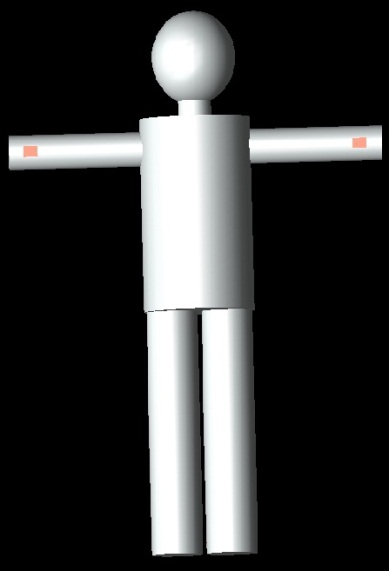
One way to understand the space suit environment is through electromagnetic (EM) simulations. We are using EMPro for our EM simulation. A simplified model of the body was built out of five cylinders (one for the torso and one for each arm and leg). The body model inside is made using three layers: skin, fat, and muscle with thicknesses of 1 mm, 3 mm, and 40 mm, respectively . The muscle thickness is slightly modified to fill the interior of the cylinders. A similar model made of aluminum functions as the Thermo-Micrometeoroid Garment. The aluminum cylinder’s radius is 4 cm larger than the body cylinder’s radius. Initial findings indicate agreement between the electromagnetic simulations and lab tests with the model suit. For example, with the arms spread straight out the electromagnetic simulation indicated a 77.9 dB path loss, while lab tests indicate a 87.5 dB path loss. The difference between these two values can be attributed to experimental error.
ENERGY HARVESTING
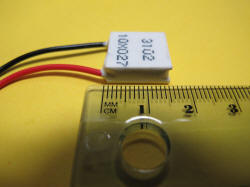
Energy harvesting could serve as an alternative to batteries. In an oxygen-rich environment, a spark from a battery could become dangerous. Energy harvesting uses readily available energy and converts it to a more usable form. Some of the most common forms of energy harvesting today are solar and wind. For a space suit sensor application, those two forms are not feasible. The two most feasible options are piezoelectric and thermoelectric. Piezoelectric approaches convert time-varying vibrations to electric power, while thermoelectric approaches convert temperature differences to electrical power. This research focuses on thermoelectric energy harvesting to capitalize on the difference in temperature between human skin and the Liquid Cooling and Ventilation Garment (LCVG). Background research was conducted with commercially available thermal generators. Samples of these products have been purchased and are being tested to characterize the power output. The LCVG is assumed to be at room temperature. To model this, we used a metal plate—representing the cooling LCVG – and an arm. The thermal generator was placed on the metal plate, and the arm rested on top. The generator provided 350 µW of power. This output is too low for continuous operation, but low-duty-cycle packet networks are being developed to operate radios at this average power level.
FUTURE WORK
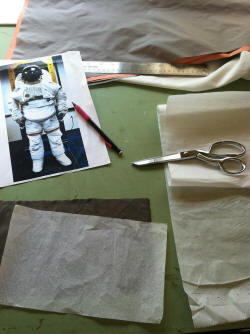
In the future, the authors hope to run tests in a real space suit. Until then the model will be used to continue testing different antennas as well as different human subjects. As testing expands with different antennas, so will the electromagnetic simulations. We plan to add to our depth of knowledge in energy harvesting by continuing to research commercially available products and test their capabilities. The journey to understanding in-suit propagation is underway.
